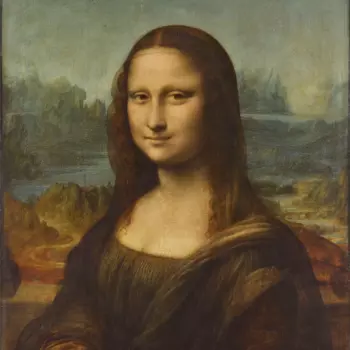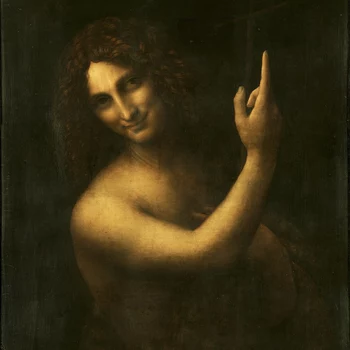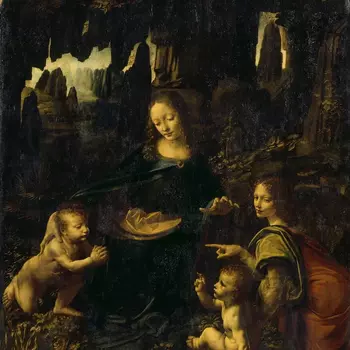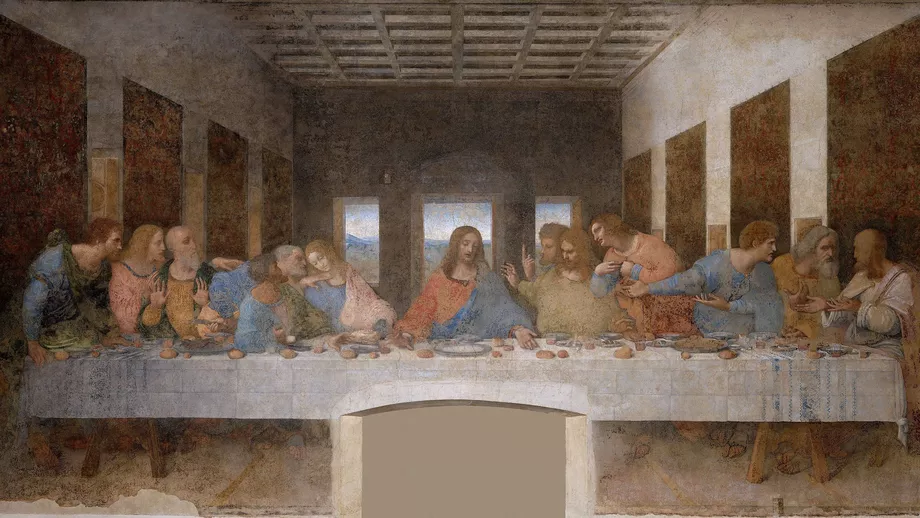
The Last Supper
The Last Supper is the only surviving wall painting by the universal genius Leonardo da Vinci. It was completed around 1498 and shows the scene in which Jesus announces to his disciples that one of them will betray him. The painting is located in the former dining room of the monks of the monastery of Santa Maria delle Grazie in Milan.
When the hour had come, he sat down at table with the apostles. And he said to them: With great longing I have longed to eat this Passover meal with you before my suffering. For I say to you: I will not eat it again until it finds its fulfillment in the kingdom of God. And he took a cup, and said the prayer of thanksgiving, and said, Take this, and divide it among yourselves. For I say unto you, From henceforth I will drink no more of the fruit of the vine, until the kingdom of God come. And he took bread, and said the prayer of thanksgiving, and brake it, and gave it to them, saying, This is my body which is given for you. Do this in remembrance of me! Likewise, after the meal, he took the cup and said, "This cup is the New Covenant in my blood, which is poured out for you. But behold, the hand of him who delivers me up is with me at the table. True, the Son of Man must go the way that is appointed for him. But woe to the man through whom he is delivered up! Then one asked another which of them it was that would do this.
Composition
The common explanations for the painting mostly focus on the group of people in the foreground. However, Leonardo emphasized the background of the figure groups through geometric symbolism, without which the work cannot be explained. In this context, it must be mentioned that Leonardo, unusually for his designs, depicts the figures within an architectural framework. Apart from the Mona Lisa, who is still visibly sitting in a loggia, Leonardo's figures are usually set against a black background or in a landscape. Among all of Leonardo's authentic and unquestionably genuine paintings, only in "The Last Supper" does he depict an architectural space in the background. With a width of approximately 9 meters, it is by far Leonardo's largest painting.
Note
The analysis of the picture composition is not yet optimized for screens below 1200px in width. There may also be some errors in the Safari browser. We will correct these issues promptly.
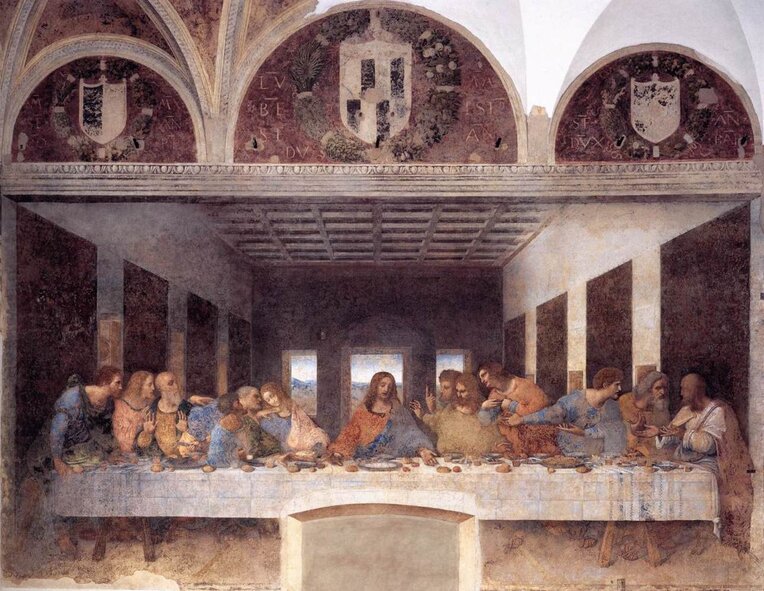

Those who are not mathematicians may not read my principles
madonna
dem Hermelin
der Täufer
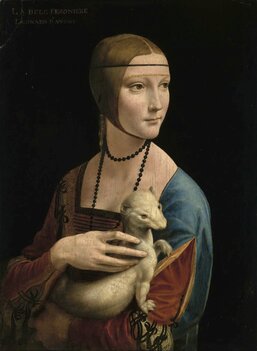
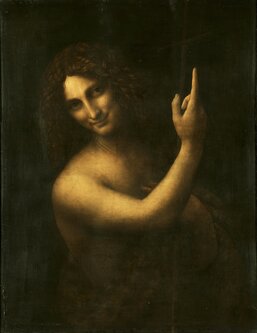

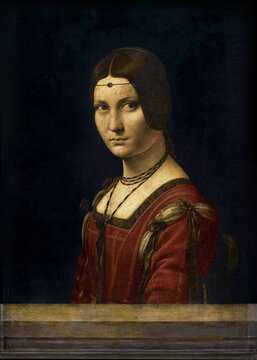
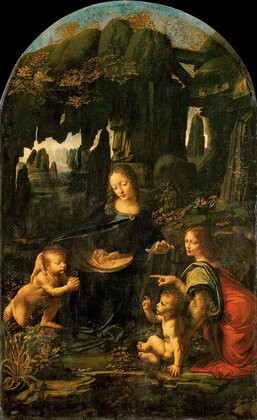
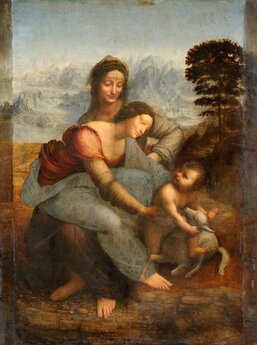
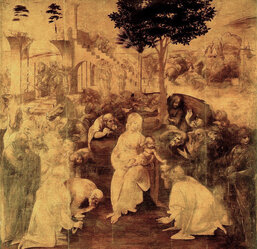
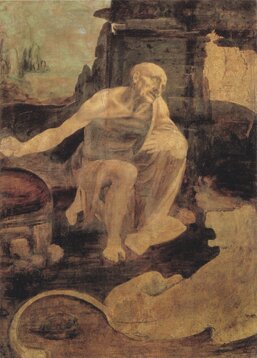
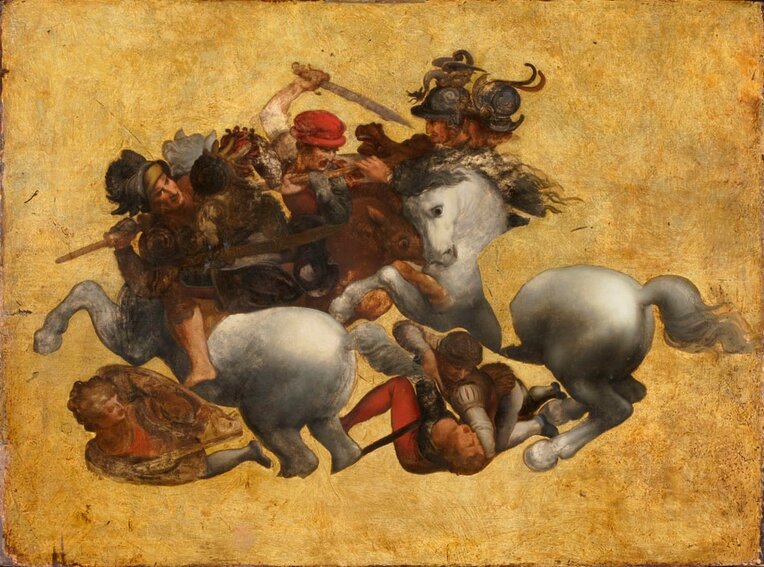

Santa Maria delle Grazie
The Last Supper is located in the Church of Santa Maria delle Grazie in Milan. The church is just a few hundred meters from Castello Sforzesco, the former stronghold of the Milanese ruling family, the Sforza. Ludovico Sforza's father, Francesco, commissioned the original construction of the church and adjacent monastery. His son Ludovico, only two years after its completion, ordered the demolition of significant portions of the church around the altar and commissioned Donato Bramante, the future architect of St. Peter's Basilica, to construct a monumental central building above the altar. Ludovico Sforza planned to use the church as a future burial place for the Sforza family.
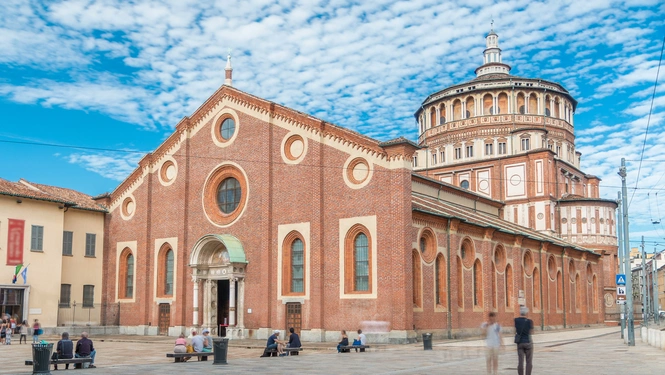
In the background the central building designed by Bramante, in front the nave of the original design. To the left of the main entrance, directly adjacent, is the entrance to the monastery building with the monks' dining room (refectory)
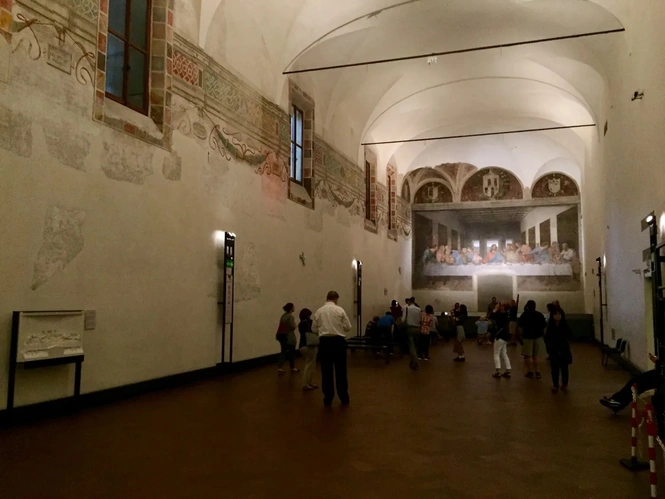
The paintings in the dining room
In 1494, two years after the start of construction work on the new dome of the church, Leonardo began painting the Last Supper in the dining room of the directly adjacent monastery. Also in the dining room, on the opposite side of the Last Supper, there is a painting of the Crucifixion scene made at the same time.
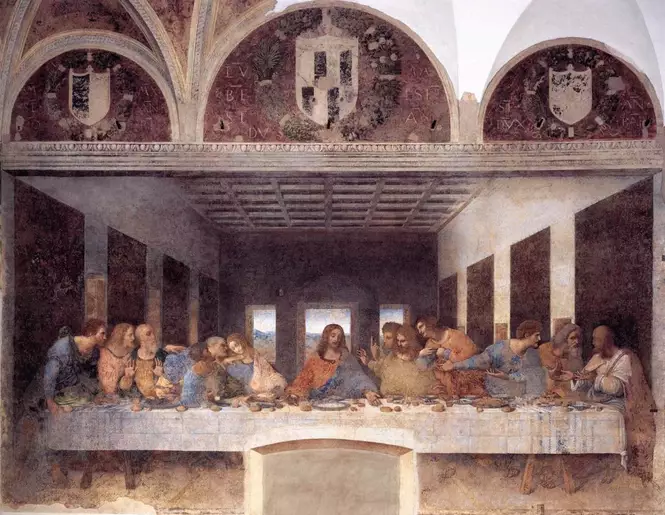
In this depiction, it is clear that the painting was very precisely incorporated into the surrounding architecture of the church.In the lower part of the painting, the outline of a door can be seen, which was cut into the wall in 1652 and later bricked up again.In the process, parts of the painting were destroyed
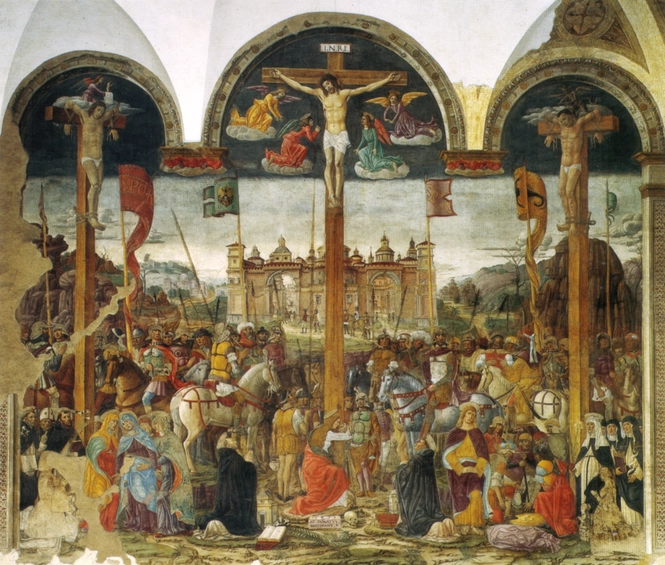
The painting, made at the same time, is on the opposite side of the room.The T-shaped three crosses on which Jesus and the thieves were struck are called the Antonius Cross. After the similarly shaped 19th Greek letter, the Antonius cross is also called "Tau" cross, more rarely "Egyptian cross", due to its similarity with the ancient Egyptian Anch symbol. The Tau Cross is the symbol of the Franciscan Order, which was especially popular during the Renaissance period in Italy.
In direct comparison with a contemporary painter, it becomes clear how revolutionary Leonardo's way of thinking about pictorial concepts was, especially considering the challenges of incorporating the surrounding architecture
Robbery, foreign use and near destruction
Since the painting was painted directly on the church walls (and thus immovable), the history of the painting is closely connected with the history of Milan.
- When Milan was conquered by the French in 1499, shortly after the completion of the Last Supper, the French king planned to take the painting and the wall to France. Because of the risks for the painting, the plan was abandoned
- When Napoleon Bonaparte, still a French general at the time, led the French Revolutionary troops to Italy in 1796, his soldiers used the monastery's dining room as a stable for their horses upon their arrival
- During World War II, downtown Milan was bombed, with Santa Maria delle Grazie severely damaged in 1943. Leonardo's Last Supper narrowly escaped complete destruction in the process
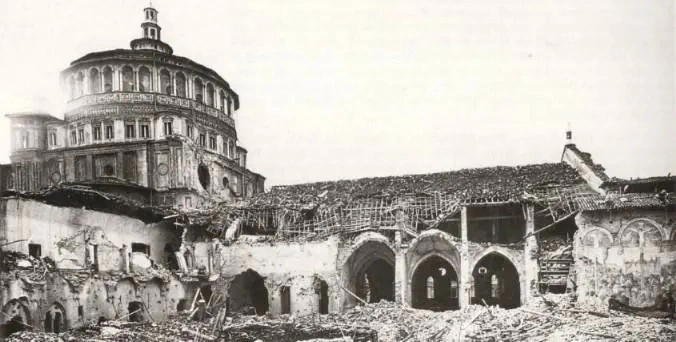
Am rechten unteren Bildrand das Refektorium:
Die Decke und eine der Seitenwände sind eingestürzt. Montorfanos Kreuzigungsgemälde auf der gegenüberliegenden Seite des Abendmahls befindet sich unter freiem Himmel (rechter Bildrand)
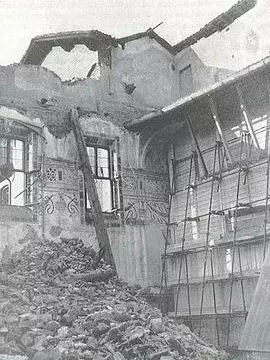

Detail views
Leonardo's Last Supper painting is being restored throughout. It is estimated that today only 20 percent of the original color pigments remain from Leonardo's time. Since it is possible that the ongoing decay of the painting cannot be stopped, it was decided to digitize the current state of the painting and thus preserve it for posterity. The work was carried out by Haltadefinizione, a company specializing in high-resolution digitization, and allows a close look down to the millimeter level. The digitized copy, which was originally free to view, unfortunately now has watermarks, but these can be removed by paying a fee. The museum responsible hopes that this will reduce the number of visitors, as the stream of visitors disturbs the room climate on the one hand, and on the other, the air and dust particles introduced have a damaging effect on the work.
High-resolution version on the Haltadefinizione website
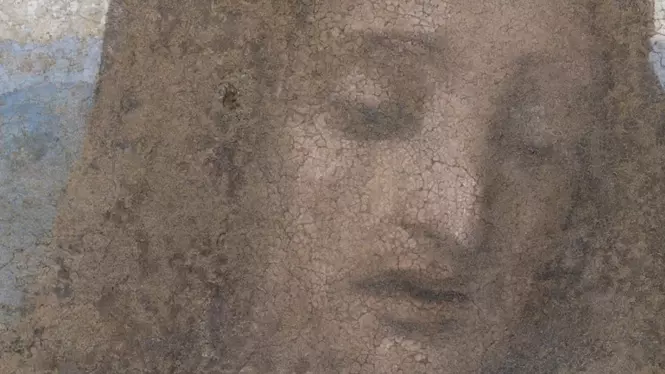
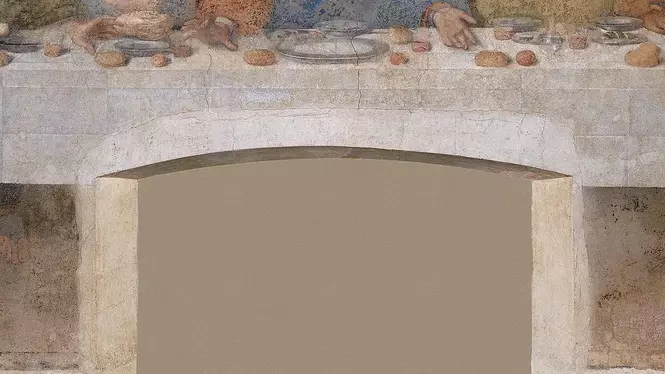
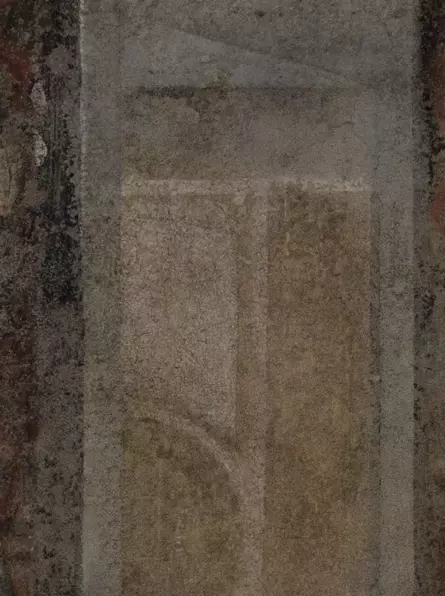
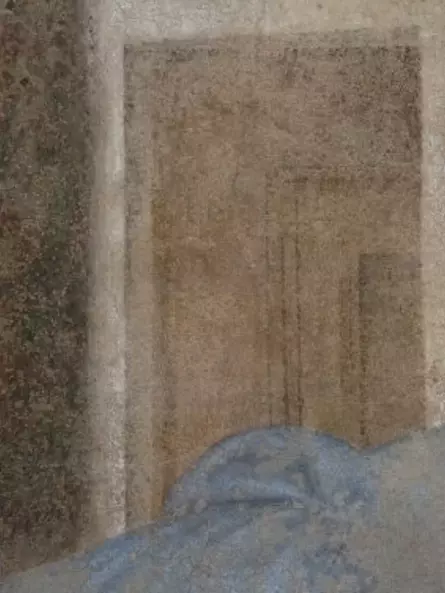
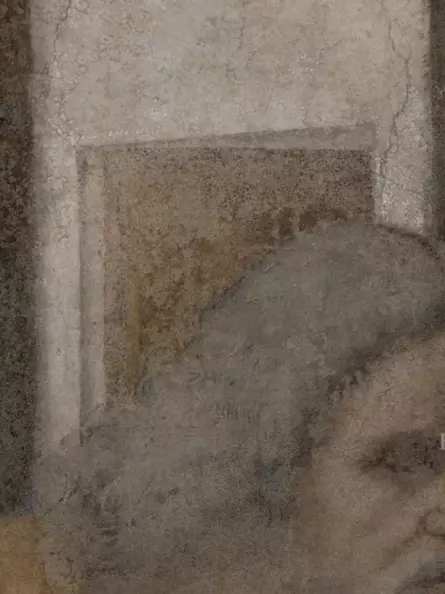
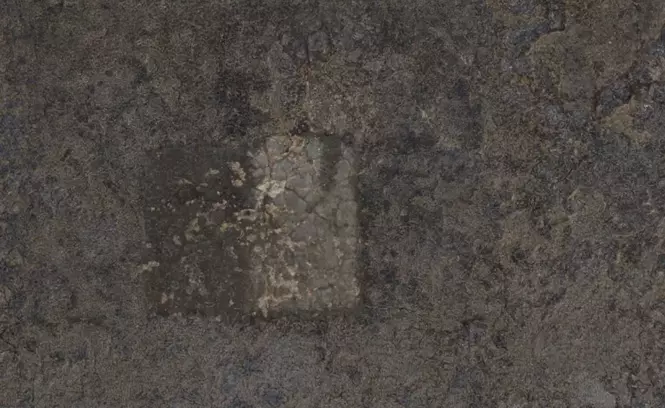
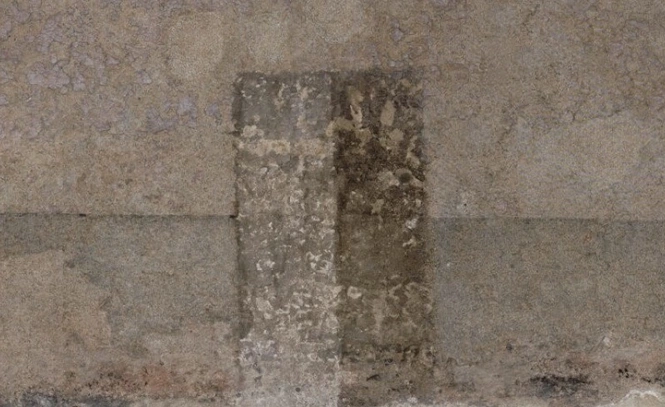


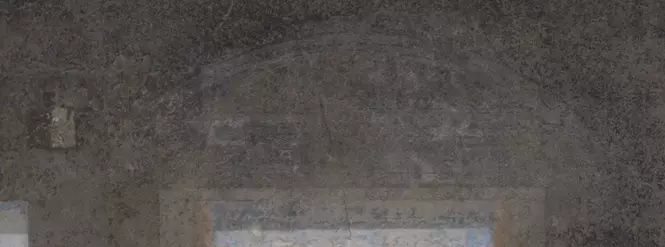
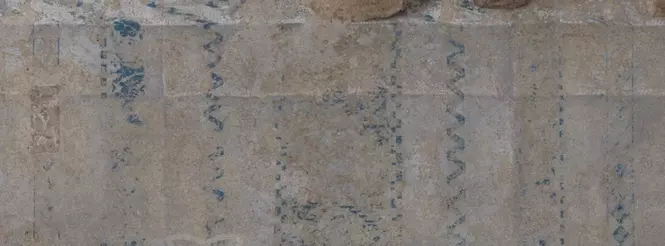
Contemporary copies
After its completion, the painting quickly gained world fame. When the French king saw it, he is said to have ordered plans to be drawn up for its removal to France. But the project failed due to the structural conditions, because it would probably have been destroyed in the process. The Last Supper is the first painting from Leonardo's workshop that was copied several times and sold at high prices due to the great demand by his students. Although the copies are not true to the original, especially with regard to the depiction of the architecture, they allow conclusions to be drawn about the original condition of the painting. For example, floral patterns can be seen on the large wall curtains, and the position of Jesus' feet is also known as a result, as well as the number of decorative lines on the floor.
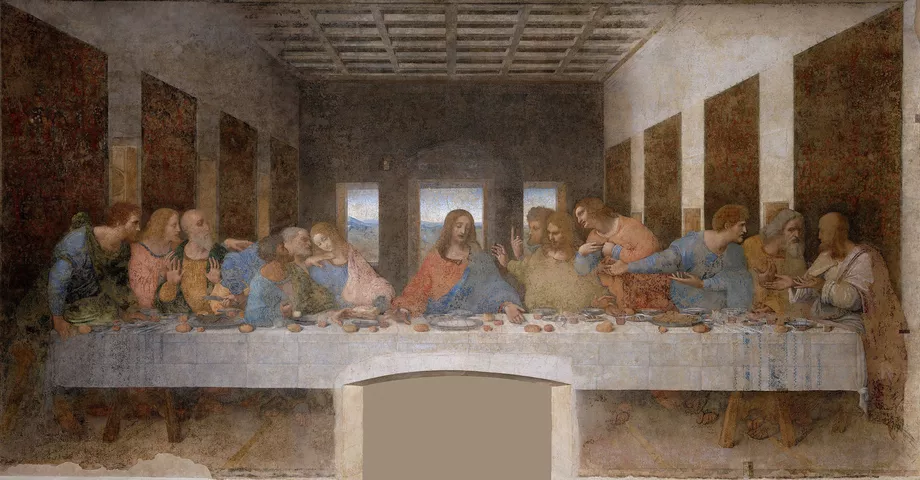
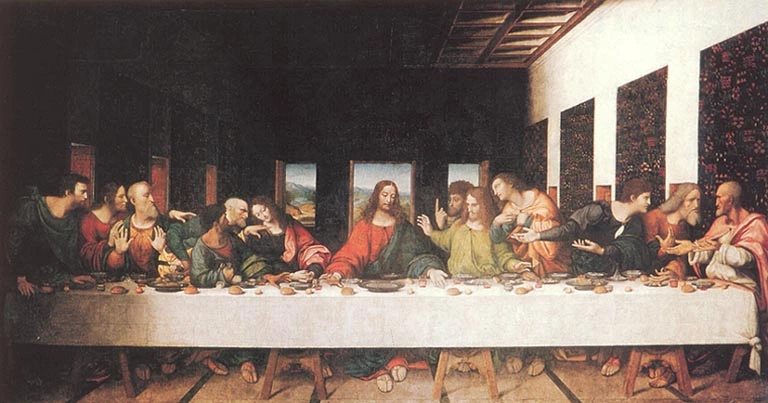
The most faithful copy of Leonardo's painting is also about the same size and was probably painted by Leonardo's most important student, Andrea Solari.
The most important similarities are the different heights of the windows on the left and right sides, as well as the number of decorative lines on the floor
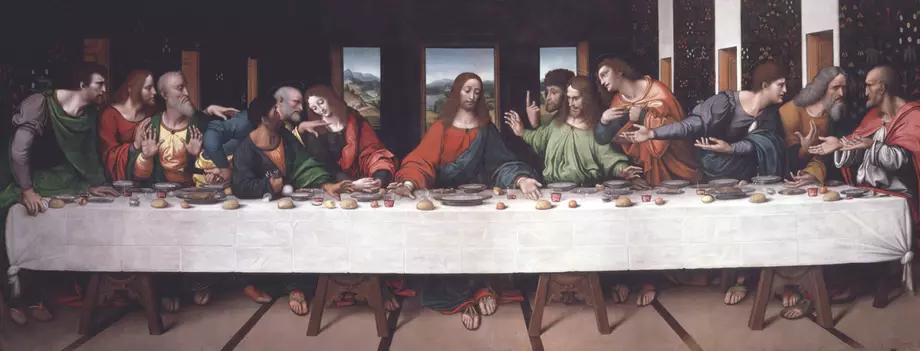
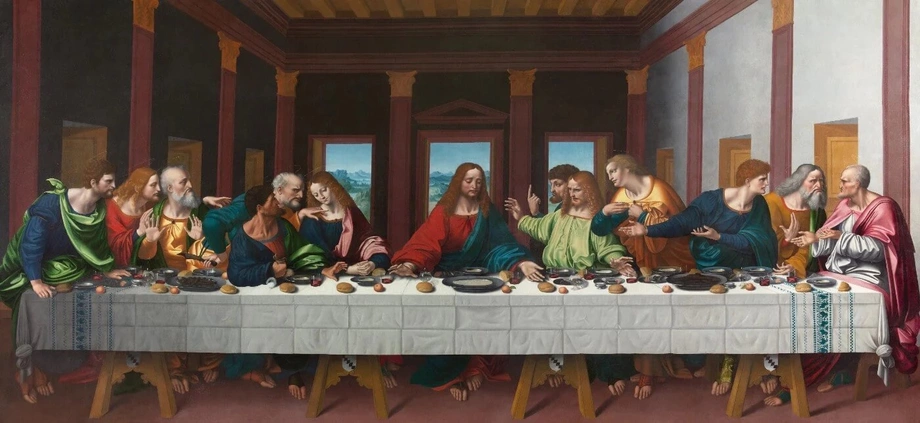
Conclusion about the contemporary copies
The copies from Leonardo's workshop seem to follow a concept, for their changes from the original are not arbitrary.
- Leonardo's most talented pupil Andrea Solari made an exact copy as far as possible
- Gianpietrino's copy, minimized in height, emphasizes the group of figures and reduces the significance of the architecture shown to the background of the picture
- Marco d'Oggiono's copy, on the other hand, stands out because it emphasizes the architecture in the painting by deviating greatly from that of the original
It must be noted that such changes could not be made without consulting Leonardo himself, who, as the head of his artist's workshop, instructed his students to make a copy. In this way, it becomes clear once again that a division of the painting into two parts seems to have been intended. On the one hand, the painting shows a group of figures in the foreground, which most viewers recognize as the actual content of the picture. On the other hand, the copies authorized by Leonardo give rise to the assumption that he wanted to have attention drawn to the picture's background on a second level. The complex geometric relationships in the area confirm this assumption. In this respect, The Last Supper is Leonardo's most artistic painting.
The severe deterioration of the painting
When considering Leonardo's version of the Last Supper, the severe deterioration of the painting must be taken into account. Unlike his other paintings, which were many times smaller, Leonardo did not paint the painting on a wooden panel, but directly on the wall plaster of an interior in a church. Since Leonardo could only paint with oil paints in order to be able to depict the fine shading and color transitions, but these did not adhere well to the substrate and therefore fell off over time, the painting was soon very badly damaged. Thus, 20 years after its creation, contemporaries reported that the painting was already falling apart (de Beatis), and 50 years later the painting was already "stained" (Vasari).
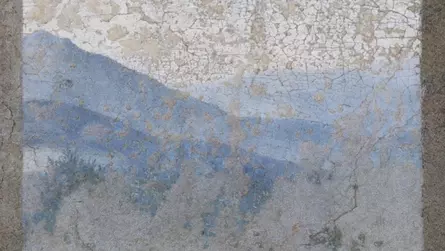
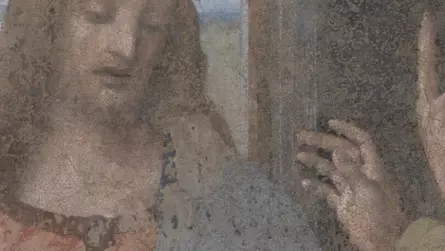
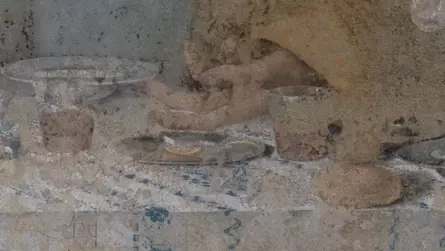
Is the Lord's Supper a heretical work?
It almost seems as if Leonardo, who did a lot of research on the durability of paintings, did not want to fulfill this claim to eternity, especially in his largest work by far in terms of area and in a depiction of Jesus, of all things. This almost heretical intention is reinforced after an analysis of the figural composition in his other two large-scale paintings, the Virgin of the rocks, painted earlier, and Virgin and Child with Saint Anne, painted afterwards. Both paintings seem to show the boy Jesus, but on closer inspection this attribution is no longer clear. At least the rock grotto Madonna was therefore considered by contemporaries to be so heretical that in the course of a court case lasting 25 years a second version had to be made, which made the identification of the two boys clearer for believing Christians.
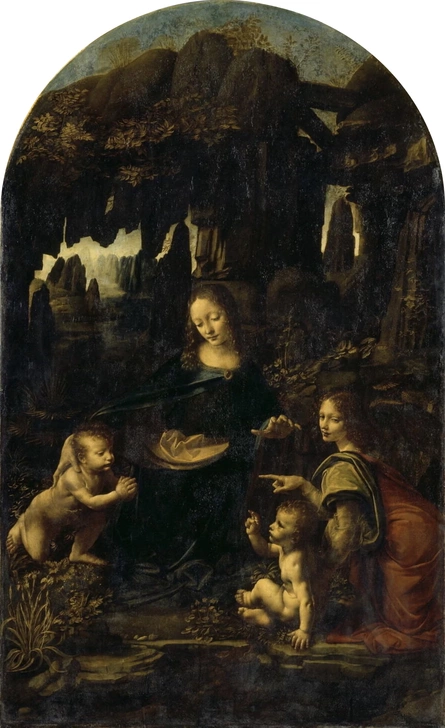
Contemporaries considered the confusion of St. John with the boy Jesus heretical. John the Baptist is the patron saint of Florence, Leonardo's hometown. Leonardo's last painting "John the Baptist" is dedicated to him.
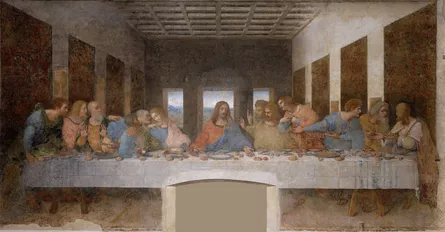
Leonardo's central major work was created between the two other large-format and undoubtedly genuine paintings of Leonardo
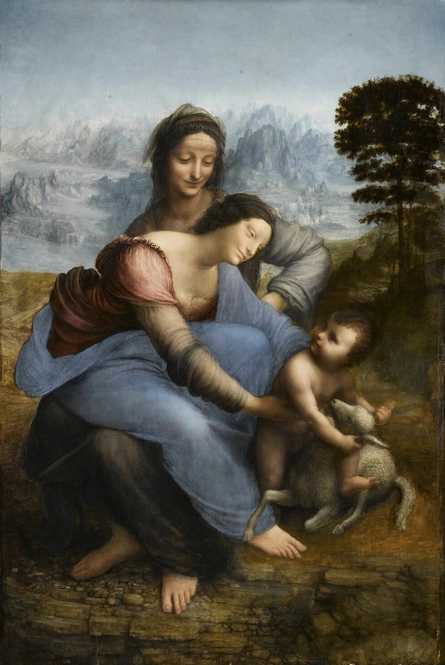
Oil on wood, 1.68 × 1.13 m
The symbolism used here also suggests that Leonardo was not depicting the boy Jesus, but the boy John playing with the lamb that symbolizes Jesus.
Probably due to the legal disputes about the Madonna of the Rocks, which lasted for over 25 years, Leonardo's allusions to the Boy John are depicted far more subtly here
Leonardo's other wall painting
It is striking that Leonardo executed only two massive wall paintings. In addition to the approximately 9-meter-wide "The Last Supper," Leonardo painted the approximately 7-meter-wide painting depicting the historical Battle of Anghiari. This painting was not completed, probably because it was not possible to get the plaster dry enough to paint due to structural dampness. The painting is only known from contemporary documents and some studies today.
It is remarkable that both of Leonardo's wall paintings have themes of religion and war—the themes of the church and the nobility—and that both paintings had to decay or could not be painted in the first place due to the painting technique used. If Leonardo had used a different technique, such as the widely spread fresco painting at the time, the paintings would be preserved much better today, similar to Michelangelo's "The Last Judgment" or Botticelli's "The Birth of Venus."
In this context, it is important to mention that Leonardo was a citizen of the Republic of Florence. This was a peculiarity at the time because medieval society was believed to consist of only three social estates: nobility, church, and peasants (the social pyramid). With the rise of the bourgeoisie, to which Leonardo belonged, a new self-confident class emerged towards the end of the Middle Ages, which, with the American Declaration of Independence (1776) and the French Revolution (1789) thirteen years later, heralded the end of the traditional dominance of the nobility and the church in Europe.
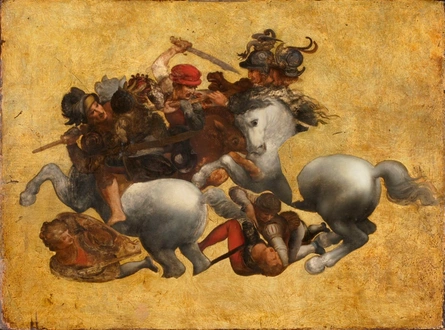
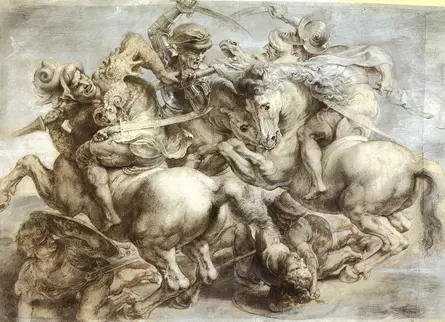
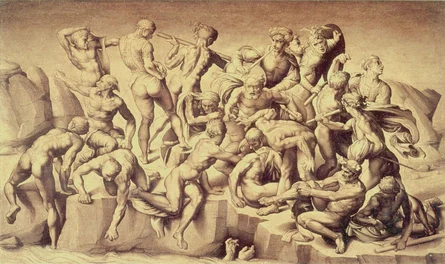
In the same room Michelangelo painted at the same time this painting, which also could not be finished
The persons
The identification of the figures is by no means as straightforward as popular science literature claims. In the Gospels, only a few of the 12 Apostles are mentioned in detail or associated with specific actions. Only two individuals from the group on the right of Jesus are clearly identifiable.
The certainly identifiable persons
- Jesus is clearly recognizable as the one who has just spoken the disconcerting words ("One of you will betray me," John 13:21)
- Judas, who will betray Jesus, holds a money bag in his right hand, alluding to the 30 pieces of silver he will receive as payment. Judas was also the financial administrator of the group around Jesus (John 13:28)
- The impulsive Peter holds a knife in his right hand. After the Last Supper, when Jesus is arrested, Peter will cut off an opponent's ear (John 18:10)
- John is traditionally depicted at Jesus's side, often in a sleeping posture. This refers to the account of the Last Supper in the Gospel of John: "One of his disciples, whom Jesus loved, was reclining at table close to Jesus" (John 13:23). Although the name of this disciple is not mentioned in the biblical text, in Christian iconography, this figure is traditionally equated with John
A notable aspect of the portrayal is the feminine features given by Leonardo to this disciple. This alludes to the fact that the group around Jesus was also accompanied by women, including Mary of Magdala (Mary Magdalene), who witnessed his crucifixion and resurrection (Mark 15:47 and John 20:1)
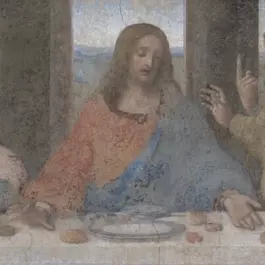
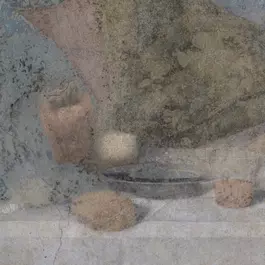
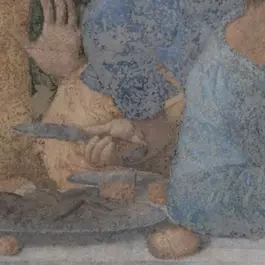
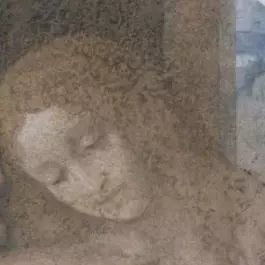
The remaining persons
The remaining figures cannot be identified with certainty. They have no definite attributes, because the Bible provides too little (or no) further information about these apostles. Partly they are mentioned there only with names. In this respect, it is highly unserious to attempt to give names to the other figures in the painting. It must be emphasized, then, that any interpretation of the group of figures that implies a biblical meaning beyond the varied design must fail because of the poor source material in the Bible itself. Instead, Leonardo has varied the facial expressions and gestures of the figures in their reactions so that they depict the broadest possible spectrum of conceivable reactions to Jesus' words.
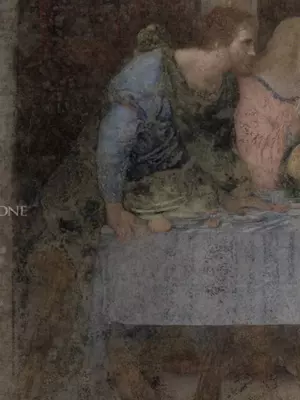
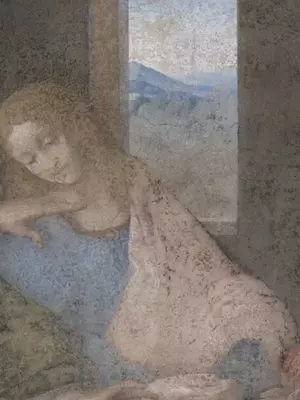
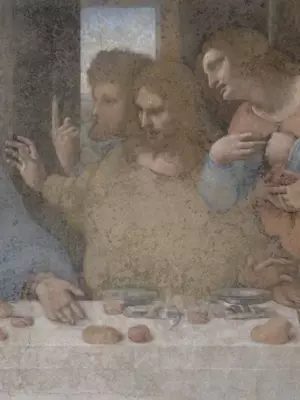
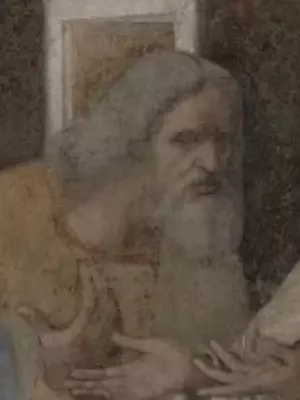
The play of hands
Worth mentioning is the rhythm of the hands, which run towards Jesus from the left as well as from the right side. At least on the left side they have a humorous function.
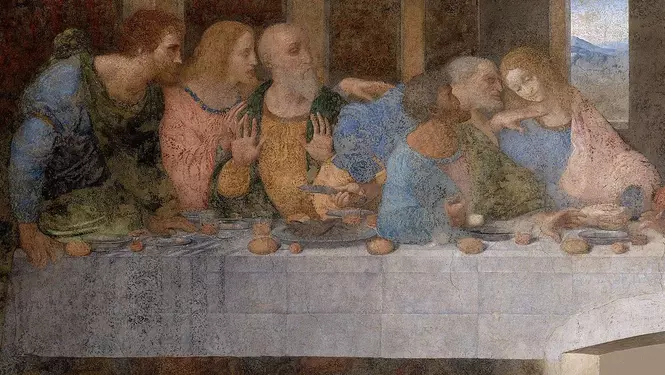
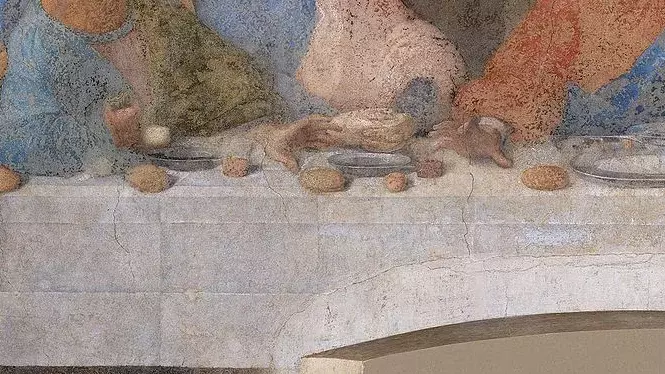
The hands of John, obviously uninvolved, are between them
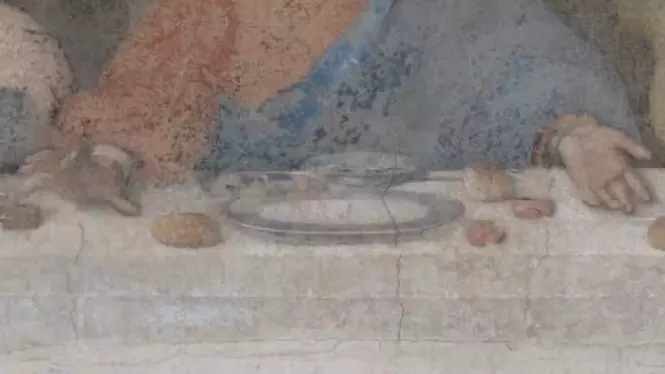
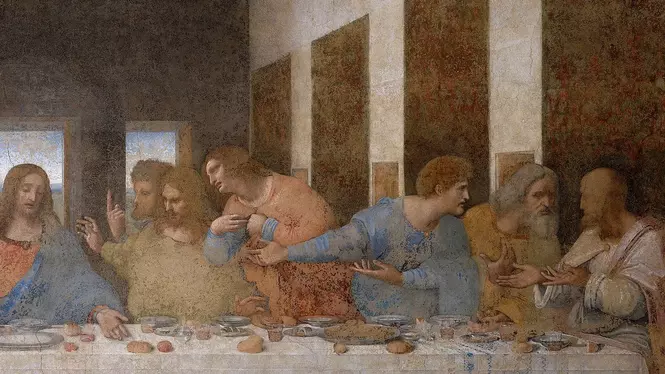
It points with the index finger upwards
The index finger in Leonardo paintings
Leonardo introduced a new iconography to John the Baptist by associating him with an upward pointing index finger (to heaven, to God, or to Jesus) in his last painting, "John the Baptist".
John the Baptist is an ascetic prophet in the New Testament who foresaw the imminent appearance of Jesus Christ and later baptized him. He was partially revered by believers as the Messiah, but said of himself that he was not worthy to untie the bootstraps of the one who would come after him (Jesus). John the Baptist thus has a preparatory function. He is the patron saint of Florence, Leonardo's hometown.


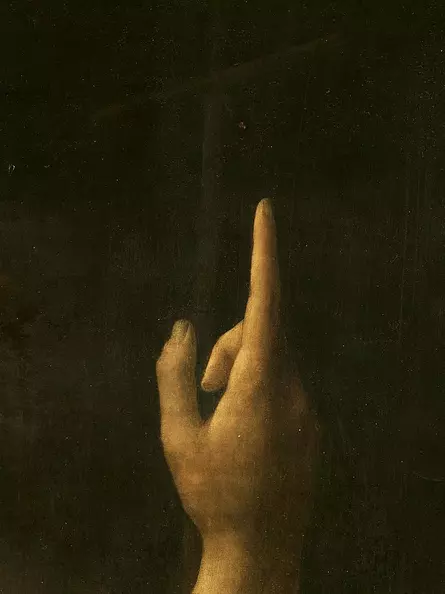
(Last undoubtedly genuine and completed painting by Leonardo)
Leonardo's last painting also shows the prominent index finger.As in the Last Supper, it points upward, but not toward the cross.Compared to the Last Supper, the hand has again been rotated about 180° along the z-axis, so that it appears again as in the Madonna of the Rocks, but rotated 90° clockwise
The hands and the reference to the architecture of St. Peter's Basilica
Against the background of Leonardo's unique art of painting, it is often overlooked that in his time he was considered the best architect in the world. He was content with the intellectual design. This is because large buildings are often very lengthy projects that leave the executing architects less room for other pursuits. Moreover, architects are always dependent on potent financiers, on whom Leonardo could not (or would not) rely. Numerous sketches by Leonardo indicate that he was involved in the planning of the construction of St. Peter's Basilica. The design for the most beautiful of the famous Loire castles in France is also attributed to Leonardo, that for Chambord Castle.
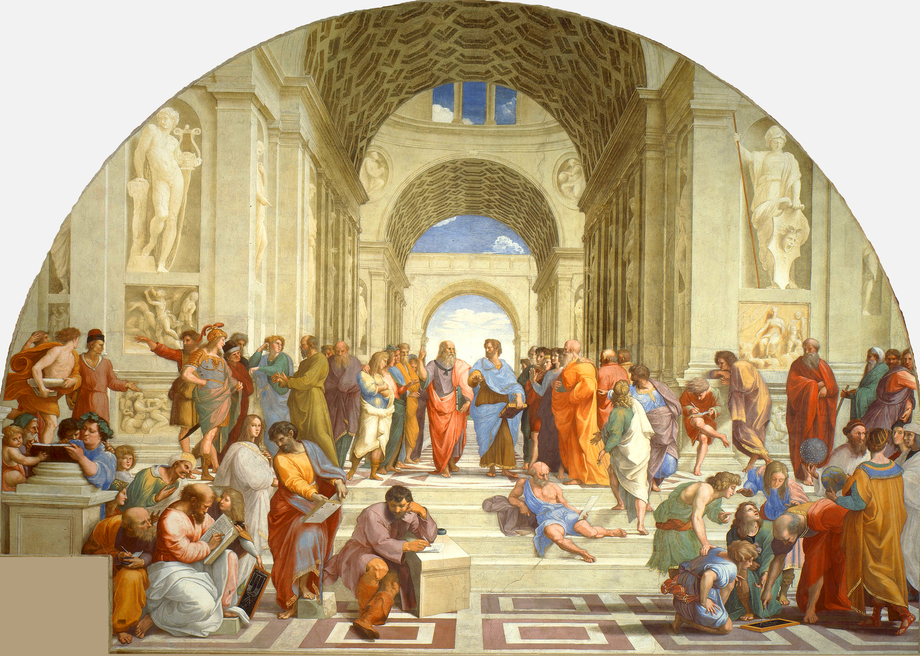
Raphael was well acquainted with Leonardo and admired him.He painted him here as Plato (left of the two central figures).Plato is also depicted with his index finger pointing upward.The architecture in the background shows the partly idealized construction site of St. Peter's Basilica in its former state, with the dome still missing at that time
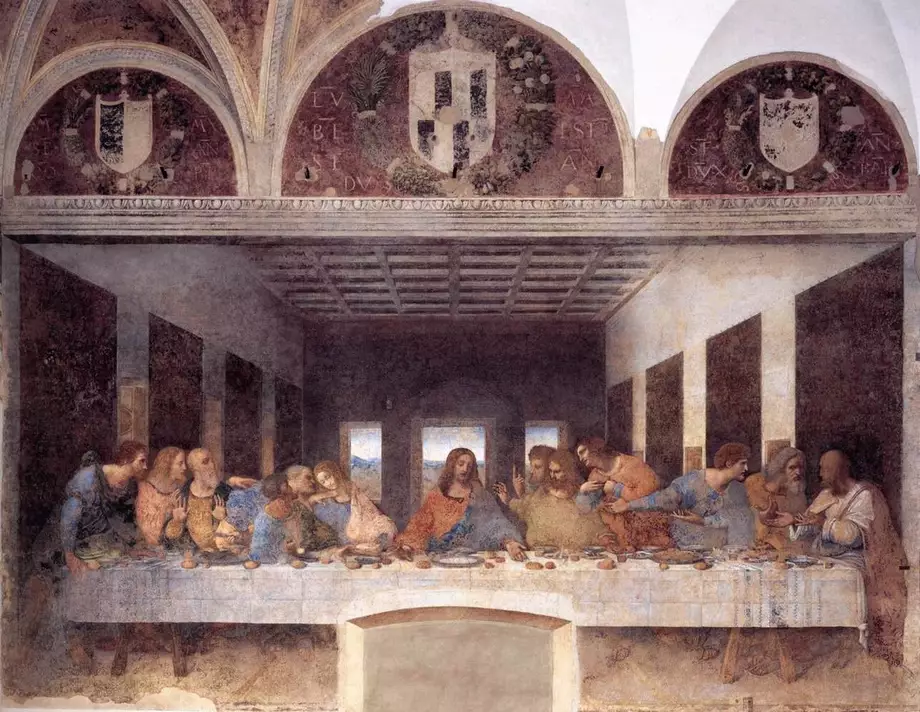
Raphael's School of Athens is a mural located in the papal apartments in Rome (Raphael's Stanze). The architectural background depicts the partly idealized construction site of St. Peter's Basilica as it was at that time. The most distinctive architectural feature of St. Peter's Basilica is its dome. The dome of the ancient Pantheon in Rome was the largest in the world until 1436 when it was surpassed by the newly built Florence Cathedral. Leonardo, as a student of Verrocchio, was involved in the final stages of the construction. St. Peter's dome is about 1 meter smaller in diameter than the one in Florence. Dome structures were considered one of the most challenging architectural types due to the numerous difficulties associated with them, persisting into the 20th century. The dome in Florence held the title of the largest in the world for approximately 400 years until 1873.
St. Peter's Basilica was designed by Bramante, who can be seen in Raphael's School of Athens wearing red robes, leaning forward, in the right foreground. Two other contemporary artists, Michelangelo and Raphael himself, are also identifiable in the painting. All of them, except for the central figure of Plato (Leonardo), share the commonality of being architects involved in the construction of St. Peter's Basilica.
The pointing finger of Plato, the compositional significance of the background architecture, and Donato Bramante are the connecting elements between Leonardo's Last Supper and Raphael's School of Athens. In 1499, Bramante interrupted his work on the dome of Santa Maria delle Grazie, where the Last Supper is located, to go to Rome and start the construction of St. Peter's Basilica. Leonardo had completed the Last Supper in the Church of Santa Maria delle Grazie the year before, after about three years of work. The raised finger in both Leonardo's Last Supper and Raphael's School of Athens most likely alludes to Leonardo's involvement in the design of St. Peter's Basilica. It is widely accepted in architectural history that Leonardo's architectural theoretical considerations prepared or strongly influenced Bramante's designs.
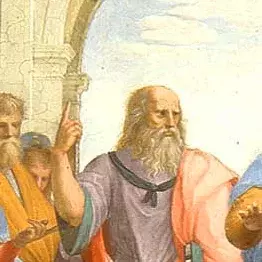
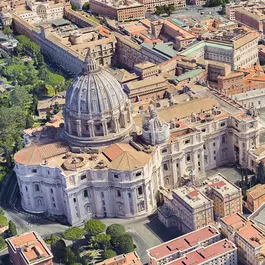
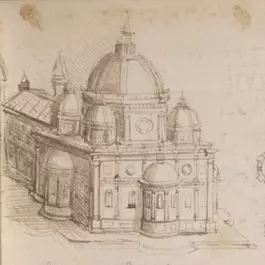
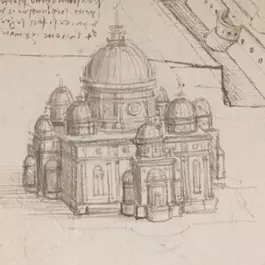
Donato Bramante was the original architect of St. Peter's Basilica. The two knew each other from their time together in Milan. Leonardo's architectural theory had a great influence on him as well
Mysticism of the Last Supper painting
Since Leonardo's Last Supper is the most famous depiction of Jesus today, and the mysteriousness of Leonardo's works is legendary, there are numerous hypotheses about a hidden message in the painting.
The table
coming soon
The chamber
coming soon
Downloads
Sources
Website of the exhibiting museum: Santa Maria delle Grazie, Milan
Frank Zöllner, Leonardo, Taschen (2019)
Martin Kemp, Leonardo, C.H. Beck (2008)
Charles Niccholl, Leonardo da Vinci: Die Biographie, Fischer (2019)
Johannes Itten, Bildanalysen, Ravensburger (1988)
Die Bibel, Einheitsübersetzung, Altes und Neues Testament, Pattloch Verlag (1992)
Euklid, Die Elemente, Verlag Europa Lehrmittel (2015)
Luca Pacioli, Divina Proportione, Die Lehre vom goldenen Schnitt, Forgotten Books (2018)
Stephen Hawking, Das Universum in der Nussschale, Hoffmann und Campe (2001)
Highly recommended
Marianne Schneider, Das große Leonardo Buch – Sein Leben und Werk in Zeugnissen, Selbstzeugnissen und Dokumenten, Schirmer/ Mosel (2019)
Leonardo da Vinci, Schriften zur Malerei und sämtliche Gemälde, Schirmer/ Mosel (2011)
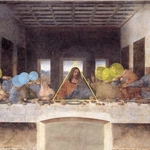
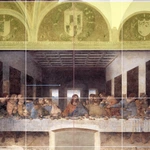
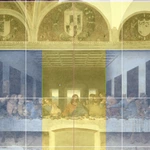
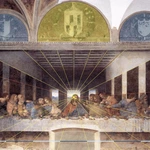
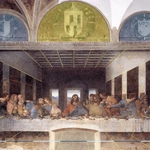
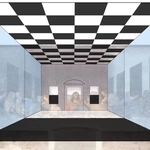
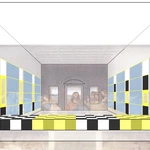
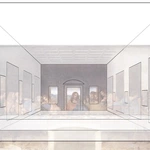
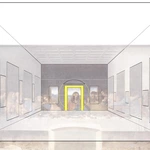
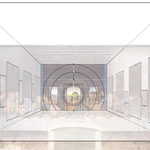
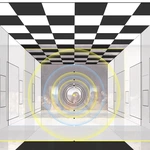
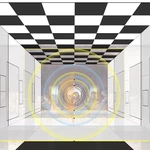
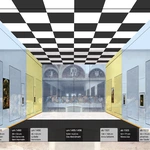
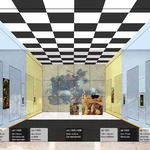
![[Translate to english:] [Translate to english:]](/fileadmin/_processed_/8/b/csm_leonardo-alle-gemaelde_2dc4b01ef6.webp.pagespeed.ce.ohfmgl8OfF.webp)
